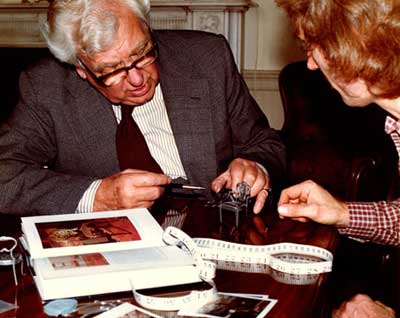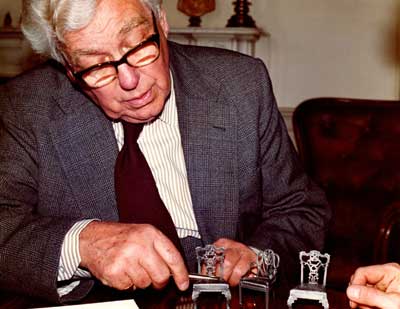From a Recent Feature in DOLLS HOUSE & MINIATURE SCENE magazine

Originally specialising in |
a collection of highly detailed |
Requiring an expert in this |
project. Mr Negus agreed to |
 |
 |
 |
| The list of chosen chairs: Elizabethan c.1590 James I c. 1620 Cromwellian Child’s c. 1650 Charles II c. 1680 William & Mary c. 1692 Queen Anne c. 1710 Chippendale c. 1755 Adam c. 1770 Hepplewhite c. 1780 Sheraton c. 1800 Regency c. 1820 Victorian c. 1860 |
at Stately Homes, Museums, Private Collectors etc. After much searching the 12 specimen chairs were assigned. There followed many meetings on location with Mr Negus and the Marque models craftsmen often visiting some of the most beautiful and historic stately homes in the country. At each visit countless photographs were taken along side all the many required measurements accurately taken checked, and double checked. Rough sketches were drawn and key features were pointed out by Mr Negus to help to ensure they had all the information for the project-as it would not have been practical for a second visit. Having obtained all of the information it was time for the team at Marque Models to plan exactly how to construct each chair for production. |
|
| Following their endorsement of the 12 it was now down to Mr Negus to find suitable examples of each proposed chair. If the project was to be a success it was vital that each chosen specimen should be a typical and first class example of each particular chair, so Mr Negus set about making contact with some of his many connections |
Once this was worked out each prototype was crafted out by hand, capturing all of the intricate details.
|
 |
|
A variety of materials including fabrics as well as brass and pewter were employed to reproduce faithfully the textured surfaces of the seat cushions, worn
leather etc. Each chair would often consist of six to eight component parts but made to fit perfectly together and ready for the first master die moulds to be made. Before each chair ‘master’ was complete Mr Negus had seen the development and only when he was happy that the detail and accuracy had been captured was his approval given and the master signed off. Having now got their 12 master chair patterns, the next step on the road to production was to make the original master moulds.These original moulds would be used to create the actual production master patterns which in tum would be used to make all subsequent production moulds - wether for pewter / white metal casting or lost wax casting suitable for casting in sterling silver or other hard metals. Once the production pieces are cast they must first be hand finished using jewellers needle files etc then they are ready for the solderers to assemble all the parts into a complete chair. This done they are now sateen polished which brings out the fine satin lustre so characteristic of pewter and at the same time highlights the intricacy of the modelling. The craftsmen at Marque Models have surpassed themselves in the creation of these delightful 1/12th scale replicas.Imagine the skills employed to faultlessly reproduce the cane seat and back of the Charles II armchair a replica standing just over 4¼” high yet retaining every detail of the open weave; and the 3 1/8” Hepplewhite armchair faithfully preserving the intricate detail of the Prince of Wales Plumes in the back of the chair. These delightful replicas are an accolade to traditional and modern skills. |
|
|
marquemodels@aol.com
Designed and handcrafted by Marque Models Limited. All Artwork, Photographs and Models copyright to Marque Models Limited.





